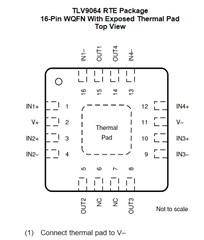Hi Team
For the TLV9064 RTE package, D/S shows the thermal pad is needed to be connected to V-.
Due to some reason, my customer connected its thermal pad to GND and the customer wants to know the possible risk or problem under the following application, could you help check it and give your comments?
- V+=3.3V, V- = -3.3V , thermal pad = GND
- V+=3.3V, V- = GND , thermal pad = GND. This should be the correct connection.
- V+=GND, V- = -3.3V , thermal pad = GND



